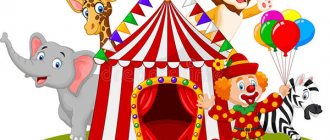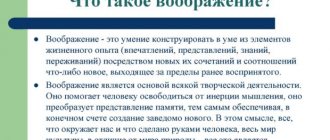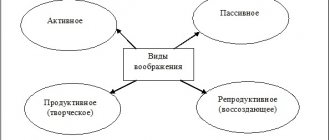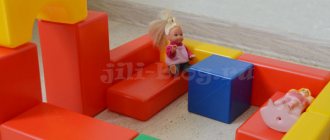Methods of pedagogical guidance of plot-role-playing games for preschool children
Methods of pedagogical guidance of plot-role-playing games for preschool children
Kashina E.V.
Currently, much attention is paid to the problem of socialization in the development and education of preschool children.
The process of socialization begins in childhood and continues throughout life. The child strives for active activity, and it is important not to let this desire fade away; it is important to promote his further development. The more complete and varied a child’s activity is, the more significant it is for the child and the more consistent with his nature, the more successful his development is. That is why games and active communication with others - with adults and peers - are the closest and most natural for a preschooler.
The plot-role-playing game is the first test of social forces and their first test.
The uniqueness of children's play requires great delicacy from an adult in the pedagogical guidance of this activity. He must become a benevolent participant in the game, regardless of whether he takes on any role or not.
What is the content of a teacher’s work in nurturing creative abilities in preschool children in role-playing games?
The teacher’s skill is most clearly demonstrated in organizing children’s independent activities. How to direct each child to a useful and interesting game without suppressing his activity and initiative? How to alternate games and distribute children in a group room or area so that they can play comfortably without disturbing each other? How to eliminate misunderstandings and conflicts that arise between them? Both the comprehensive education of children and the creative development of each child depend on the ability to quickly resolve these issues.
When leading role-playing games, educators are faced with the following tasks:
• development of games as an activity (expanding the themes of games, deepening their content);
• using the game to educate children's groups and individual children,
Directing a role-playing game requires great skill and pedagogical tact. The teacher must direct the game without disturbing it, and maintain the independent and creative nature of the game activity.
Preschool pedagogy describes many methods and techniques of influencing children, the choice of which depends on the specific situation.
There are methods and techniques that help enrich the content of the game: the teacher plays the main role; individual play between the teacher and the child, with the teacher playing the main role; introducing figurative toys; parallel game technique; role-playing game with continuation; activating communication between an adult and children during their play, aimed at awakening and independent application by children of new ways of solving a game problem, at reflecting new aspects of life in the game; telephone game; playing out scenes of life in kindergarten with the help of dolls; playing out imaginary situations with children. And also those that contribute to the regulation of gaming relationships: games that facilitate adaptation (“come visit me”), the participation of the teacher in the game (the main role); use of a multi-character plot (2 doctors, 2 drivers); introducing a puppet character, setting rules of behavior on his behalf; creation of multi-age play triads.
Methodological methods and techniques give results and bear fruit only in those cases if the teacher applies them systematically, takes into account the general trends in the mental development of children, the patterns of formed activity, if he knows and feels each child of his group well
The teacher’s task in working with older children is to expand and deepen their play interests and create conditions that encourage children to be creative. The teacher, with his advice, suggestions, and questions, should guide the children to find an independent way out of difficult situations. Gradually, the teacher moves from being a direct participant in the game to the role of an adviser in it. In addition, the teacher consistently leads children to the use of all previously undeveloped play tools, the production of play aids, the introduction of toys with the obligatory discussion of the issue of how these toys are used. In the future, the teacher, when working with older children, teaches them to transfer the acquired knowledge into play and continues to develop their basic planning and organizational skills.
The teacher must guide the game without destroying it, preserve the amateur and creative nature of children’s play activities, the spontaneity of experiences, and faith in the truth of the game. The teacher influences the play concept and its development, enriching the content of children’s lives: it expands their ideas about the life of adults, about the relationships between people, and thereby concretizes the content of a particular play role.
However, in expanding the knowledge and understanding of preschoolers, it is necessary to observe moderation. An overabundance of impressions can lead to superficial reflection in games of the unimportant and random, to their instability, and lack of organization.
A game is a means through which children demonstrate their independence during the distribution of roles and actions during the game. The child lives in the game. And the task of educators is to become a guide and link in the child-game chain, tactfully supporting the leadership to enrich the children’s gaming experience.
Senior preschool age
Direct Leadership Techniques
- inclusion of the teacher in the game, taking on a role (main or secondary) - not often, as necessary (showing a speech sample, collective discussion of the role behavior of the players after the game).
Indirect Leadership Techniques
– enriching children’s social experience through all types of activities (observations, excursions, reading fiction, watching children’s TV shows, conversations)
— involving children in the production of attributes and design of playing fields.
Creating conditions for the development of creative role-playing games:
— creation of an object-game environment;
— use of a modern storage system (arrangement of game material in containers);
- inclusion of “semi-finished toys” into the environment for making homemade products;
— replenishment and enrichment of the gaming environment in accordance with the knowledge acquired in the classroom.
Adult help
- remember events that are more suitable for the game, establish their sequence;
— plan the course of the game, the sequence of actions;
— distribute roles, agree on plans;
— assistance in solving game problems, maintaining cognitive interest in the game;
- watching children play;
- direction of children’s plans and actions (advice, hint, question, change in the play environment);
— creation of problematic situations (flexible influence on the game concept, plot development, complication of ways of displaying reality;
- create a game situation;
- individual work (if the child does not know how to play, you can use the experience of children who play well).
MAGAZINE Preschooler.RF
THE PROBLEM OF MANAGING THE PLOT-ROLE-PLAYING PLAY OF A PRESCHOOL CHILDRENIn the modern understanding, a game is “a form of activity in conditional situations aimed at recreating and assimilating social experience, fixed in socially fixed ways of carrying out objective actions, in subjects of science and culture”
At each age stage there is a leading type of activity that has a decisive influence on the formation of personality. Such an activity for a preschooler is a role-playing game, which, thanks to pedagogical guidance, becomes a form of organizing life. “The game in condensed form contains, as if in the focus of a magnifying glass, all development trends; the child in the game seems to be trying to make a leap above the level of his usual behavior,” writes L.S. Vygotsky.
The game is considered by psychologists (Vygotsky L.S., Zaporozhets A.V., Rubinstein S.L., Elkonin D.B., etc.) as the most developed form of creative activity. It is no coincidence that the famous game researcher D.V. Mendzheritskaya consistently defended the name “creative” rather than plot-role-playing games, relying on L.S. Vygotsky, who noted the emergence of a plan in the play activities of preschool children, in implementing which the child reflects social reality, but does not copy it, but combines his ideas about it, conveys his attitude to what is depicted, i.e. creates..
Modern studies of the play activity of preschoolers confirm the correctness of L.S.’s ideas. Vygotsky. It has been established that the formation of a child’s personality occurs through play. It is precisely this that ensures that the preschooler identifies and comprehends socially accepted moral norms of behavior, and forms the main driving motive for the child’s personal development – to be like an adult. The adult becomes the “moral center” of the game for the preschooler, a role model. A new form of motives develops in the game: from pre-conscious, affectively colored immediate desires to generalized intentions (Bozhovich L.I.).
Considering play as one of the “main areas of children’s upbringing before school,” A.P. Usova believes that “game will become a powerful educational factor if it is used in the pedagogical process to organize the lives of children and their activities. This means that the most important manifestations of the life of preschool children, namely their interests, requests, communication, etc. will be organized and satisfied with games and forms of play.”
The importance of role-playing games in the formation of arbitrariness of behavior is especially highlighted in psychological and pedagogical research. Researcher O.A. Karabanova emphasizes that “joint role-playing game... represents the zone of proximal development of the child’s arbitrary behavior, where interaction and cooperation with peers provide the conditions for objectification and further internalization of the ability to regulate one’s activities”
Throughout preschool childhood, the dynamics of play development are observed from the first level (in junior preschool age) to the fourth (in senior preschool age). But, as data from mass practice show, only a small percentage of children reach the fourth level of play development by the end of preschool childhood. This situation certainly affects the general mental and personal development of preschoolers.
When analyzing the features of creative play, the main analyzed characteristic is its content. The content develops from games where the main content is a reflection of the real actions of adults, to games that reflect relationships between people, and, finally, to games in which the main content is submission to the rules of social behavior and relationships.
The content of the game is the essential factor that determines the development of a “good” game. The criteria for such a game are the following:
- the presence of morally and mentally developing content;
- development of imagination and creativity;
- friendliness in relationships;
- the joy of realizing one's strengths.
However, as evidenced by research data (Artemova L.V., Gasparova E.M., Zvorygina E.V., Novoselova S.L., etc.), as well as our observations, in children, kindergarten students, creative play is often is stereotypical. It is often a strictly regulated activity, monotonous and more reminiscent of frontal classes, where everything is predetermined by the teacher and there is no room for the child’s creativity.
Among the reasons for this state of the game are the following:
- lack of understanding in the minds of adults - parents and educators - of the value of children's play.
- the position of the teacher as a passive observer or as a dictator of the child’s actions and behavior in the game;
- the presence of the same toys and attributes in all kindergarten groups, which are too detailed and lead children to the same way of using them;
- insufficient amount of unformed play material to stimulate the child’s imagination.
The more meaningful the game, the more opportunities for the child’s development. In turn, the content of gaming activity depends on the complexity of the goals set. A.N. Leontyev emphasizes that “... in real life... goal formation acts as the most important moment in the formation of one or another activity of the subject... it is necessary to raise the question of goal formation... the selection and awareness of goals is not an automatically occurring and not a one-time act, but a relatively long process of testing goals through action and their, so to speak, substantive content.”
Such identification, testing and substantive filling of activity goals is ensured primarily by the connection between learning and play.
The essence of the relationship between learning and play was revealed at one time in the research of A.V. Cherkova. The psychologist drew attention to the fact that with the introduction of education in kindergartens, the following paradoxical phenomenon began to be observed: in the process of classes, children are imparted a fairly extensive amount of knowledge, but this is reflected insignificantly in the game. A.V. Cherkov comes to the conclusion that when the unity of goals is established in educational activities, work and play, the development of the latter is significantly intensified. To do this, it is necessary to establish as closely as possible a connection between the program material of the lessons and the interests manifested in the game. Subsequently, R.I. Zhukovskaya reveals the types of connections that exist between classes and play.
These are the following types of connections:
- the connection between conducting imaginative didactic games and creative, independent ones;
- the connection between observing people's work on excursions, artistic reading and the development of social interests in the roles of “adults” ;
- the connection between reading works of fiction about our contemporaries, holding conversations about what they read and the subsequent development of interests in games;
- the connection between design learning activities and the development of interests in independent construction games;
- the connection between the development of interest in independent games - dramatizations and the conduct of dramatizations in the classroom [9].
The teacher's purposeful development of these connections leads to a significant increase in gaming interests. However, until now, play in preschool institutions is rarely creative, but is characterized by a reproductive nature. It is not the nature of children to copy ready-made situations, as teachers suggest. A study of mass practice shows that in approximately 30% of cases, educators do not manage role-playing games at all; in 27%, such guidance comes down to the question “What are you playing? ”and only in 29% of cases do teachers take an active part in games (according to L.G. Semushina). Thus, in practice, the importance of play as a means of personality development and as a form of organizing children’s lives is underestimated.
The teacher, unfortunately, is often not perceived by the child as a person involved in the children's community (that is, primarily as a person who plays), as an emotionally interested interpreter of the events of the surrounding life that the child constantly encounters and which interests him.
Analysis of the state of management of children's games shows that most educators do not strive or do not know how to be “together” with children in play as often as possible. Most often, the teacher adheres to the position “above the children,” which is most convenient for him.
Independence, ease, creativity, variety of children's play are its prerequisites. But, like any activity, it does not arise spontaneously, but is formed (but not imposed!) by adults. Therefore, the problem of a teacher mastering the technology of organizing children's play is extremely relevant.
Our observations indicate that the reasons for the teacher’s difficulties in guiding a preschooler’s play are associated, first of all, with the insufficient level of development of his professional and pedagogical skills.
A study of the professional functions of a teacher was conducted by L.G. Semushina. She identified the following groups of skills:
- Analytical skills (the ability to analyze and evaluate the level of development of the play activity of each child and the group as a whole; the ability to analyze and evaluate a specific role-playing game).
- Design skills (the ability to design the level of development of gaming activities, plan management techniques, design the development of a specific role-playing game).
- Information skills (the ability to select material to provide children with impressions, convey it to children in a form accessible to them, arouse interest in it, desire to reflect it in games).
- Organizational and communication skills (the ability to encourage children to agree on the start of the game, choose a topic, discuss a game plan, select and make the necessary equipment, toys and items that replace them).
The formation of the above skills involves the following areas of work in preschool institutions: this is, first of all, the development of pedagogical consciousness. The teacher needs to know the psychology and pedagogy of a child’s play, be able to diagnose the level of development of each child and the group as a whole, and thoroughly study all the phenomena of reality that are the source of children’s play. However, “the high professional level of a preschool teacher presupposes not only the presence of deep knowledge (general and special), but also his ability to educate a creative personality” [12, p. 226]. Therefore, we have highlighted such an area as work on the development of pedagogical thinking. The creativity of a teacher does not allow for simple copying of someone else's experience. To create a model of creative work on the formation of children's play, the teacher needs to skillfully operate with pedagogical knowledge, argue his own opinion (the ability to predict play situations, children's behavior and select adequate methodological techniques).
At the same time, the level of children's play is directly dependent on the guidance of the teacher. And at the same time, play should be a free and independent activity that arises on the child’s initiative. Compulsion to play turns it into a regulated activity. Play is the only type of children's activity where a preschooler can act without coercion, based on his own interests and needs, having the opportunity to freely choose. If this is not taken into account, then the game ceases to be such a free activity.
However, a preschooler, due to his insufficient life experience, cannot yet adequately assess and understand the phenomena of the surrounding reality that are reproduced in his game, and therefore cannot learn moral standards of behavior. To a certain extent, not only the modeling of the education process, but also his creative position in conducting the game depends on the teacher, since it is the teacher who selects the means of influence on the child. Therefore, the main thing in pedagogical activity is to change the nature of interaction between an adult and a child. An adult should take the position not of a passive observer, but of an active partner in the game.
To ensure this, in our opinion, it is necessary:
- the ability to respond to children’s play, to be aware of the emotional state of each participant;
- the ability to change the nature and content of communication with children in accordance with the development of the plot of the games. For this purpose, problematic game situations are used, which are created by changing the object-game environment and activating communication between an adult and children;
- the teacher’s knowledge of the phenomena of reality that are the source of the content of children’s play, his readiness and ability in a certain way to convey information accessible to children’s understanding, to stimulate the manifestation of children’s various creative abilities and children’s activities;
- the ability to select the most appropriate (in connection with the level of development of the game’s plot) means of pedagogical influence that form in the child the image of an adult whom he strives to imitate;
- modeling of possible results of the game, which allows the adult partner to imagine the possible behavior of children in different roles.
Each of these conditions cannot be purely reproductive.
There must be a creative component in the teacher’s activities. When leading the game, he must be able to coordinate his actions and verbal guidelines with constant changes and complications of the plot. The degree of children's interest in the game depends on the position of the teacher as a partner, consultant and senior comrade.
Continuing this thought, it should be noted the importance of the teacher having a professional sense: understanding where and how to get involved in the game, when to come to the rescue in the implementation of the plan or quietly leave the game, giving the children the opportunity to show their creativity, their understanding of what is being depicted.
Guiding play activities requires the teacher to be able, in the role being portrayed, to outwardly express their feelings and thoughts through speech, facial expressions, and movements. Taking a playful position, the teacher promotes the development of independence, initiative, and creativity of children in role-playing games.
LITERATURE
- Psychology: Dictionary/Under general. ed. A.V. Petrovsky, M.G. Yaroshevsky. – M.: Politizdat, 1990. – P.127.
- Vygotsky L.S. Game and its role in the mental development of a child // Issues of psychology. – 1996. – N 6. – P.75.
- Pozdnyak L. Mendzheritskaya D.V. – researcher of play in preschool children. //Preschool education. – 1995. – No. 12. — P.10.
- Usova A.P. Pedagogy of the game and its pressing problems. In the book: The role of play in raising children. – M.: Education, 1976. – P.15.
- Doronova T.N., Karabanova O.A., Solovyova E.V. Game in preschool age. – M.: Publishing House “Education of Preschool Children”, 2002. – P.20.
- Elkonin D.B. Psychology of the game. - M.: Pedagogy, 1978.
- Leontyev A.N. Problems of activity in psychology // Issues of philosophy. – 1972. – N 9.
- Cherkov A.V. Development of conscious relationships in children in play. - Teacher zan. Height. Ped. Institute, 1958. - P. 3-92.
- Zhukovskaya R.I. The game and its pedagogical significance. – M.: Pedagogy, 1975. – 112 p.
- Mikhailenko N., Korotkova N. Towards a portrait of a modern preschooler. // Preschool education. – 1993. – N 1. – P.32.
- Semushina L.G. Study of the professional functions of a preschool teacher. In: Improving the training of preschool specialists. – M.: MGPI, 1982. – P.87.
- Kononko O.L. Social-emotional development of specialness. – K.: Osvita, – 225 p.
| Next > |






